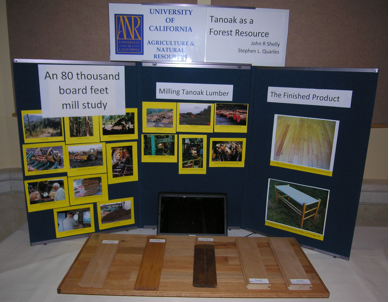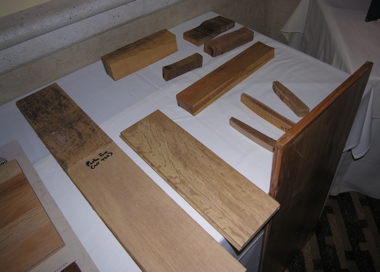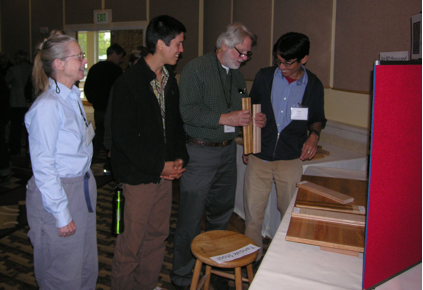Will tanoak die out – is it worth saving? Tanoak (Lithocarpus densiflorus) is a California native hardwood tree common in the forest of Northern California and susceptible to Sudden Oak Death (SOD). Since tanoak is not a commercial tree should we just let it die? Tanoak has stumped manufacturers and researches alike trying to find a place for it in the market. It has many first-rate material properties but it has a reputation of being very difficult to dry without creating serious drying defects. The Fifth Sudden Oak Death Science Symposium was held in Petaluma, CA from June 19-22 to address the current knowledge of SOD and devoted a day to shed light on tanoak’s worth. The conference brought together scientists, researchers, and other experts to share information and solutions. More information on the conference presentations can be found at the conference website.
Friday’s session focused on tanoak’s importance and value. Its history and background were discussed first, summarizing its uses, advantages vs. disadvantages and economic viability. This was followed by a discussion of the efforts and studies being done to prevent tanoak trees from succumbing to SOD. The conference did an excellent job of connecting people, bringing people from different fields together to share knowledge and expertise on how to use and protect tanoak.
A presentation, titled “Tanoak as a Forest Product Recourse: Past, Present, and Future”, by John Shelly and Steve Quarles, two University of California forest products experts was presented by Steve, currently employed at the Insurance Institute for Business & Home. This presentation looked at tanoak as a potential lumber resource and compared it to more traditional hardwood species. Tanoak has a rich history as an acorn food source for Native Americans, a source of tannin—a natural chemical used to produce leather from animal hides, firewood, lumber, and pulp for paper. Compared to Northern red oak (a benchmark species), tanoak is stronger and harder, however it is more difficult to dry and exhibits greater tangential and radial shrinkage. More information is available at the UC Woody Biomass Hardwood Utilization webpage. An accumulation of experience from various researches and practitioners has led to core knowledge of best practices. These include avoiding the dark-colored core zone as it cannot be dried without defects, quarter-sawing lumber to improve dimensional stability, and using a drying schedule of air drying to 30% MC followed by a mild kiln-drying schedule. Additionally restraining the movement of wood as it dries by placing a uniform weight of about 150 lbs/ft2 on top of the lumber stack as it dries is known to be beneficial in reducing warp.
Some people are concerned that removing trees that are inflicted with the SOD tree disease pathogen will increase the risk of spreading the disease. Research reported by Shelly however, indicated that the very low risk of spreading the disease when fresh cut wood is transported to different locations disappears entirely once the wood is processed and dried. In fact, using diseased wood my even have some positive benefits. Further information is presented at: http://ucanr.org/sites/WoodyBiomass/HardwoodUtilization/SOD/ .
One such potential benefit is the presence of spalted wood –an early stage of decay—often found in SOD diseased trees. This, combined with the insect tunnels often associated with SOD infected trees creates an appealing aesthetic appearance, often called character wood. This character has the potential to set it apart from other woods. However, it was noted that spalted wood should not be used for flooring because the hardness of the wood with incipient decay is greatly reduced making it too soft for flooring. The interesting appearance of spalted wood can be very attractive in furniture, art, and craft uses. This could create a niche market for SOD-diseased tanoak that is unique, appealing to select buyers.
The participants in the tanoak session also had the opportunity to view an exhibit of a display of pictures, a slide show, and examples of tanoak lumber and finished products (e.g. flooring and furniture). The pictures and slide show depicted tanoak lumber being cut and quartered, then dried. Here the audience could see the preparation process—from forest to flooring—as well as examples of drying effects. Many people’s questions revolved around the option of using tanoak for flooring and its expected durability. Another common topic was the amount of unutilized tanoak in California forests. It is clear that there is continuing interest in finding uses for this tree. The UC experts concluded that with expansion of the market and improvements in the processing we could see a dramatic increase in the use of tanoak across California.
Attached Images:


